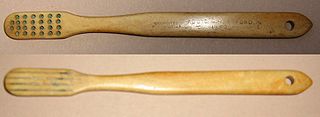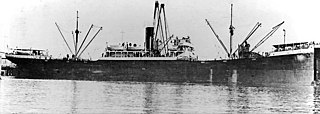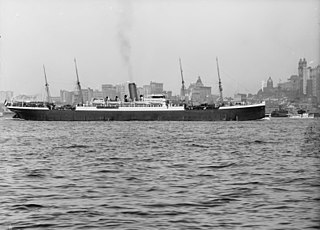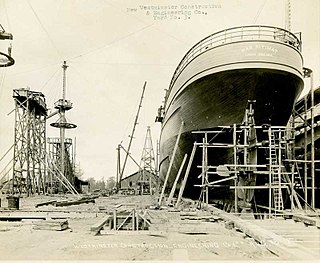
SS Breda was a Dutch cargo-passenger ship sunk in Scotland during World War II.

USS West Carnifax (ID-3812) was a cargo ship in the United States Navy shortly after World War I. After she was decommissioned from the Navy, the ship was known as SS West Carnifax, SS Exford, and SS Pan Royal in civilian service under American registry.
Persier was a 5,382 GRT cargo ship which was built in 1918 as War Buffalo for the British Shipping Controller. In 1919, she was sold to Belgium and renamed Persier. Between 1934 and 1941 she also held a passenger certificate. She was driven ashore on the Icelandic coast in a storm in February 1941 which put her out of action for two years. Returned to service in February 1943, she served until 11 February 1945, when she was torpedoed and sunk by U-1017 with the loss of 20 crew.

SS Empire Simba was a British steam-powered cargo ship. She was originally an American ship, launched in 1918 as SS West Cohas. During a stint in the United States Navy from 1918 to 1919, she was called USS West Cohas (ID-3253).
Belgian Airman was a 6,959-ton cargo ship which was built by Harland & Wolff Ltd, Glasgow in 1941 for the Ministry of War Transport (MoWT). She was launched as Empire Ballantyne and transferred to the Belgian Government in 1942. She was sunk by a German U-boat on 14 April 1945.

SS West Gotomska was a steel–hulled cargo ship built in 1918 as part of the World War I emergency wartime shipbuilding program organized by the United States Shipping Board.
SS Hastier was a 749 GRT coaster which sank on her maiden voyage in April 1919.

USS Berwyn (ID-3565) was a United States Navy cargo ship in commission from 1918 to 1919. She saw service in the final weeks of World War I, then entered commercial service in 1919 as SS Berwyn. She was wrecked in 1920.
Scantic was a 326 GRT coaster that was built in 1936 by Noord Nederland Scheepsmakkerij, Groningen as Dr Colijn for a Dutch owner. In 1940, she was transferred to the Ministry of War Transport (MoWT) and renamed Empire Crocus. In 1947, she was sold into merchant service and renamed Stainton. A further sale in 1951 saw her renamed Benwood. In 1955 she was sold to Finland and renamed Monica. A further sale to Sweden in 1957 saw her renamed Mona. In 1963, she was sold to Denmark and renamed Scantic, serving until 7 December 1964 when she foundered in St Georges Channel, United Kingdom.
SS Andrios was a cargo ship which sailed for a number of owners under several names before sinking off the Berlengas Islands, near the coast of Portugal, in 1926.

SS Main was an ocean liner of the Rhein class of North German Lloyd. She was in service on the route from Bremen to Baltimore from her 1900 launch until seized by the Allies of World War I in 1914, and was involved in the 1900 Hoboken Docks Fire. Unlike her sister ships Neckar and Rhein, she never entered service for the United States Navy.

SS Espagne was a Belgian cargo ship that was torpedoed by the Imperial German Navy submarine SM UC-71 in the English Channel off St Catherine's Point, Isle of Wight, England, while she was travelling from Le Havre, France to Newport, Wales.
SSKeltier was a Belgian cargo ship that was torpedoed by U-55 in the Atlantic Ocean while she was travelling from Milford Haven, Wales, United Kingdom, to New York, United States, in ballast.
The SSBruges was a Belgian cargo ship that was shelled by the German auxiliary cruiser Thor in the South Atlantic at.
SS Auguste Helmerich was a German cargo ship that collided with SS Normandiet off Dalarö while on a voyage from Kotka, Finland to Hamburg, Germany with a cargo of wood.
SS Daram was a Design 1001 wooden cargo ship that ran aground on Long Bar Reef, Bermuda, while she was travelling from Pensacola, Florida, United States, to Marseille, France.

SS War Kitimat was a freighter built in Canada for wartime service during the First World War. She was steam-powered, with a hull made of wood.
Cockaponset was a steam cargo ship built in 1918–1919 by Pacific Coast Shipbuilding Company of Bay Point for the United States Shipping Board as part of the wartime shipbuilding program of the Emergency Fleet Corporation (EFC) to restore the nation's Merchant Marine. The vessel was largely employed on the Gulf Coast of the United States to Europe route until 1930 when she was laid up. In late 1940 the ship together with 15 other vessels was acquired by the British government to alleviate significant shortage of tonnage due to an ongoing German U-boat campaign. In May 1941 the freighter was torpedoed and sunk on her first war trip to the United Kingdom.
Lakeside Bridge was a steam cargo ship built in 1919 by Submarine Boat Company of Newark for the United States Shipping Board (USSB) as part of the wartime shipbuilding program of the Emergency Fleet Corporation (EFC) to restore the nation's Merchant Marine. The vessel was chiefly employed on the East Coast and Gulf to Europe routes throughout her short career. In December 1920 the vessel went ashore in strong gale and was wrecked without loss of life.







